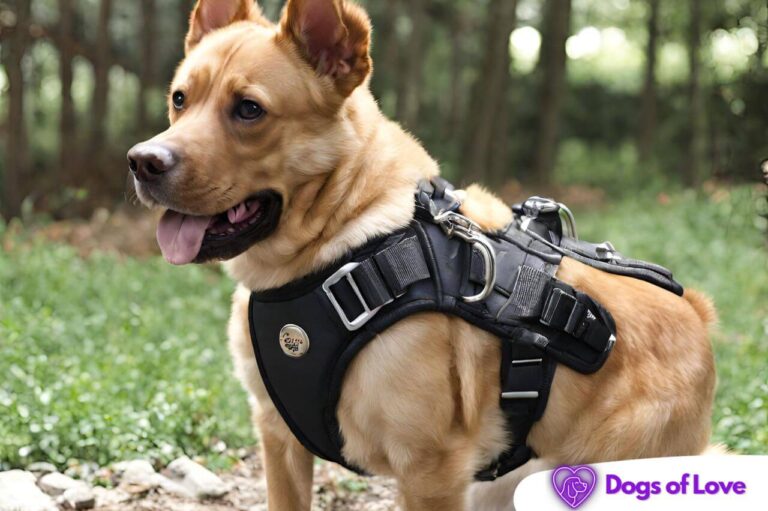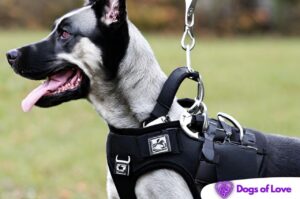Lifting a dog by its harness is a practice that many pet owners might find convenient, especially when assisting their furry friends into a vehicle or over obstacles.
However, whether it is detrimental to lift a dog by its harness is a matter of concern for responsible dog owners.
While harnesses are primarily designed for walking and controlling a dog, their usage in lifting situations has sparked debates within the pet community.
In this discussion, we will explore the potential risks and benefits of lifting a dog by its harness and when it may be appropriate or inadvisable to ensure the safety and well-being of our canine companions.

What are The Pros of lifting your dog by harness?
Lifting your dog by its harness can offer some advantages in specific situations.
One of the key benefits is that it allows you to support your dog’s weight more evenly, reducing the strain on their neck and throat, which can occur when lifting by the collar.
This is especially important for small breeds or dogs with delicate necks that may be prone to injury.
Lifting by the harness can also provide better control and stability, making it easier to guide your dog safely, particularly in challenging or potentially dangerous environments.
Furthermore, for dogs with surgical procedures, injuries, or mobility issues, a harness can provide a secure and gentle way to assist them in getting up or down from various surfaces, offering comfort and minimizing discomfort.
However, it’s essential to exercise caution and proper technique when lifting by the harness to avoid potential risks.
What are The Cons of lifting your dog by harness?
Lifting a dog by its harness, while potentially beneficial in certain circumstances, also has drawbacks that require careful consideration.
One significant concern is that not all harnesses are designed for weight-bearing, and using them for lifting might place undue stress on the harness’s stitching or attachments, compromising its structural integrity.
Another issue is that improper lifting techniques, such as jerking or pulling, can cause discomfort or pain for the dog, especially if the harness doesn’t fit correctly.
Moreover, for dogs with existing health conditions or injuries, lifting by the harness may exacerbate their discomfort or harm their recovery process.
To mitigate these risks, it’s crucial to select a harness suitable for lifting purposes, ensure it fits properly, and always lift your dog with care and gentleness, keeping their well-being as the top priority.
Can lifting a dog by a harness cause long-term health issues?
Lifting a dog by a harness, if done incorrectly or excessively, can potentially lead to long-term health issues.
Using a harness not designed for lifting or lifting a dog too often may put undue stress on the harness and the dog’s body, leading to discomfort, chafing, or even injury.
Lifting too high can strain a dog’s spine and shoulders, while lifting too low may cause friction and skin problems.
Prolonged or repeated incorrect lifting could potentially lead to musculoskeletal issues, such as back or joint problems, and may exacerbate any existing health concerns.
To prevent long-term health issues, it’s essential to choose the correct harness, ensure proper fit, and lift your dog with care and consideration, adhering to safe and gentle lifting techniques that minimize the risk of harm.
What are the Tips for Using a Harness to Lift Your Dog Properly?
Lifting your dog by a harness can be done safely and effectively by following some essential tips.
First and foremost, ensure that the harness you are using is designed and rated for lifting, as not all harnesses are suitable for this purpose.
Proper fit is crucial, as a well-fitting harness minimizes the risk of discomfort and injury.
When lifting, always support your dog’s rear end to distribute the weight evenly and minimize strain on their back.
Lift gently and smoothly, avoiding sudden jerks or pulls, and be mindful of your dog’s comfort and any signs of distress.
For dogs with health issues or injuries, consult your veterinarian for guidance on the safest way to lift and support your pet.
By following these tips, you can ensure that using a harness to lift your dog is a safe and comfortable experience for you and your furry friend.
How to Tell if You Are Lifting Your Dog Too High or Too Low Using a Harness?
Determining if you are lifting your dog too high or too low using a harness requires attentive observation and focusing on your dog’s comfort and safety.
When lifting too high, you might notice your dog’s discomfort, such as whining, struggling, or trying to reposition themselves.
If their legs are dangling in the air or their back is arched unnaturally, it’s a sign that the lift is too high.
Conversely, lifting too low can strain your dog’s back or hindquarters.
Signs include your dog’s legs dragging on the ground or having difficulty walking or moving comfortably while being lifted.
To find the ideal balance, ensure the harness supports your dog’s body and that their legs can move without dragging.
Always pay close attention to your dog’s cues and body language, adjusting your lifting technique to ensure their well-being during these maneuvers.
How often should you check the condition and fit of your dog’s lifting harness?
Checking the condition and fit of your dog’s lifting harness should be a regular part of your routine as a responsible pet owner.
It’s advisable to perform these checks before each use, mainly if your dog relies on the harness for mobility or support.
Ensure the harness is free from fraying, loose stitching, or signs of wear and tear that could compromise its structural integrity.
Additionally, check that all buckles and attachments are secure and functioning correctly.
In terms of fit, always assess that the harness is snug but not too tight, allowing a couple of fingers to fit between the harness and your dog’s skin.
Regularly monitoring the condition and fit of the harness helps to maintain your pet’s safety and comfort during lifting, ensuring a positive experience for both you and your canine companion.
In conclusion
Lifting a dog by its harness can be a helpful and safe practice with proper care and consideration.
While there are potential risks associated with lifting by the harness, such as strain or discomfort, these can be mitigated by using a harness specifically designed for lifting, ensuring a secure and comfortable fit, and employing gentle and controlled lifting techniques.
The choice to lift your dog by a harness should be guided by the individual needs of your pet, especially if they are senior or have mobility issues.
Always be attentive to your dog’s comfort and well-being, and consult with a veterinarian if your pet has any health concerns.
When performed mindfully, lifting by a harness can be a valuable tool for supporting and assisting your canine companion without compromising their long-term health or safety.








